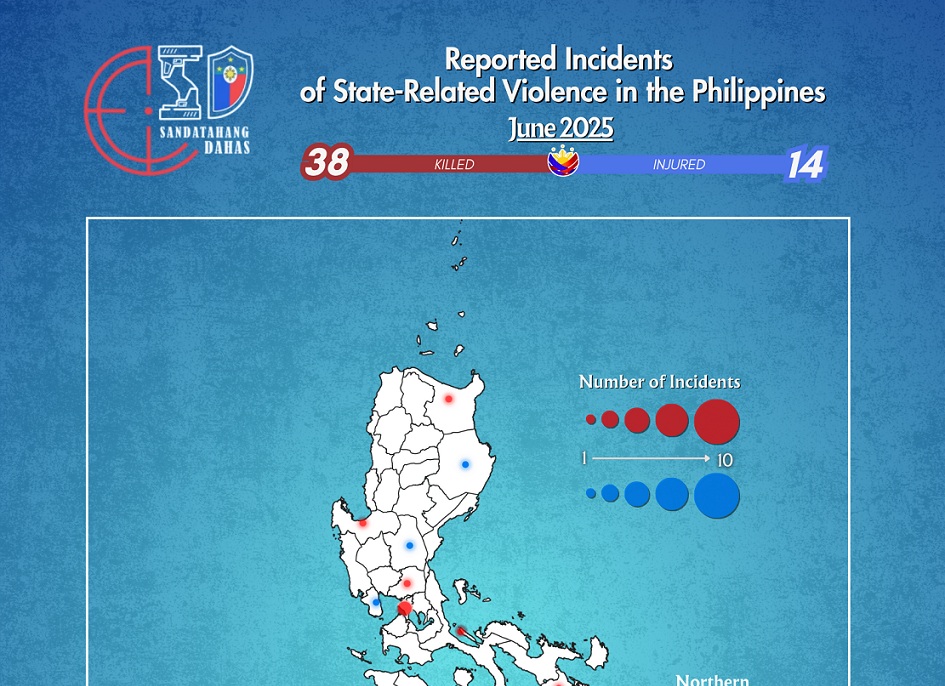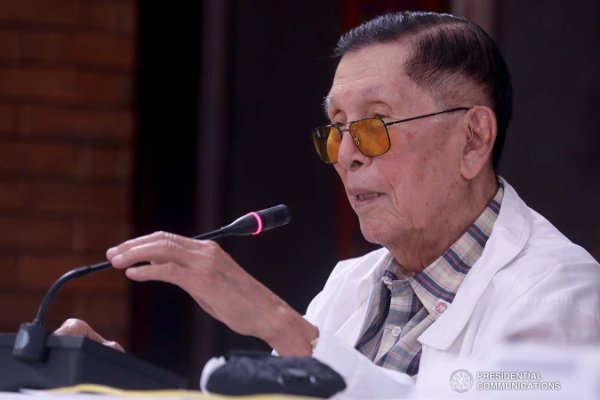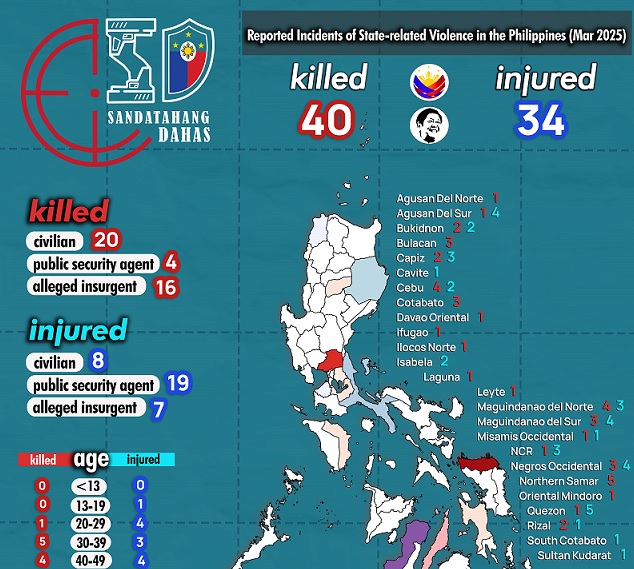Nearly half of the 38 killed in June were alleged insurgents making last month the deadliest for the Communist Party of the Philippines-New People’s Army halfway through 2025 based on Sandatahang Dahas, a monitor by the UP Third World Studies Center.
In June 2025, the Sandatahang Dahas monitor recorded 52 cases of state-related violence: 38 killings and 14 injuries. The killings of the 38 were attributed to the police and the military.
Of the 38, 18 were alleged members of CPP-NPA.
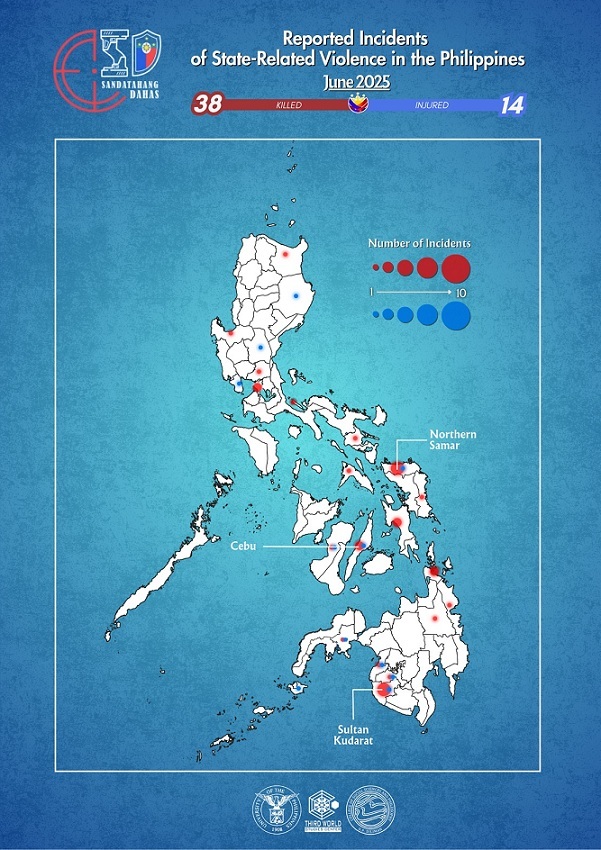
If three others allegedly affiliated with the Dawlah Islamiyah and the Abu Sayyaf were to be included, the total number of alleged insurgents killed this month is 21. (Sandatahang Dahas uses “alleged insurgents” as a catchall category for anti-government forces that resort to political violence yet may have significant ideological differences and varying degrees of strength and legitimacy as a movement.)
June also comes in at a close second to March in terms of number of killings, with the latter having a total of 40 cases. However, with 14 cases, this month records the lowest number of injuries. Yet even with that small number, the police and the military, as with the killings, were the ones mainly responsible. State agents were involved in 11 of the 14 cases. In the three other cases, they were the ones on the receiving end.
Many of the killings this month were linked directly to Armed Forces of the Philippines (AFP)-led operations targeting suspected NPA members. From five cases in May, the number rose sharply to 18 in June. This was mainly due to multiple casualties in counterinsurgency operations. Of the eight encounters between the AFP and the CPP-NPA with casualties, four have at least three fatalities on the part of the CPP-NPA. In Northern Samar, five NPA casualties were reported. Leyte, Surigao del Norte, and Sultan Kudarat reported three NPA casualties each.
On June 3, five NPA members were killed during a pursuit operation in Northern Samar. Three of the fatalities were identified as Noel Lebico Sr. of Barangay Roxas in Catubig, Arnel Aquino of Barangay Osmeña in Palapag, and Nonoy Norcio of Barangay Luneta in Gamay. Their identities were confirmed by alias In-In, a former vice squad leader under the NPA Eastern Visayas Regional Party Committee, who had surrendered to government forces. The two other casualties were unidentified. The Philippine Army’s 8th Infantry Division carried out the operation.
On June 15 in Surigao del Norte, the AFP’s 4th Infantry Division killed three NPA soldiers identified as Roderick Maco Bensing, a top leader of the NPA North Eastern Mindanao Regional Committee, Liezl Dagohoy, and another unknown female member.
In another clash in Sultan Kudarat on June 19, three alleged NPA members were killed by the Philippine Army’s 37th Infantry Battalion. Two minors who were also alleged NPA members were severely injured and arrested by the AFP. The CPP-NPA killed a soldier in the encounter. The only one that the military or the police will have as a casualty for June.
In Carigara, Leyte, three individuals were killed by AFP forces, including Juanito Sellesa Jr., alias “Tibor”, an executive committee member of the Island Committee Levox under the NPA Eastern Visayas Regional Party Committee, along with two of his comrades.
Brig. Gen. Noel Vestuir, commander of the Philippine Army’s 802nd Infantry Brigade, stated that the military is encouraging rebels to surrender before the end-of-month deadline and return to their families through government programs. He warned that those who continue to fight may face the same fate as the NPA members killed in Carigara, Leyte.
But not all killings were the result of legitimate encounters.
In Surigao del Sur, Elioterio Ugking, a 25-year-old lumad farmer, was reported to have been accidentally shot by Jericho Campano, a member of the Citizen Armed Force Geographical Unit (CAFGU). The victim’s family refutes the claim about his death, stating that the suspect allegedly bound and assaulted the victim before killing him. The retrieved belongings of Ugking also had multiple bloodstains and gunshot marks. It was also mentioned that the 9th Special Forces Company tried to bribe the victim’s family and neighbors to keep them from reporting the incident.
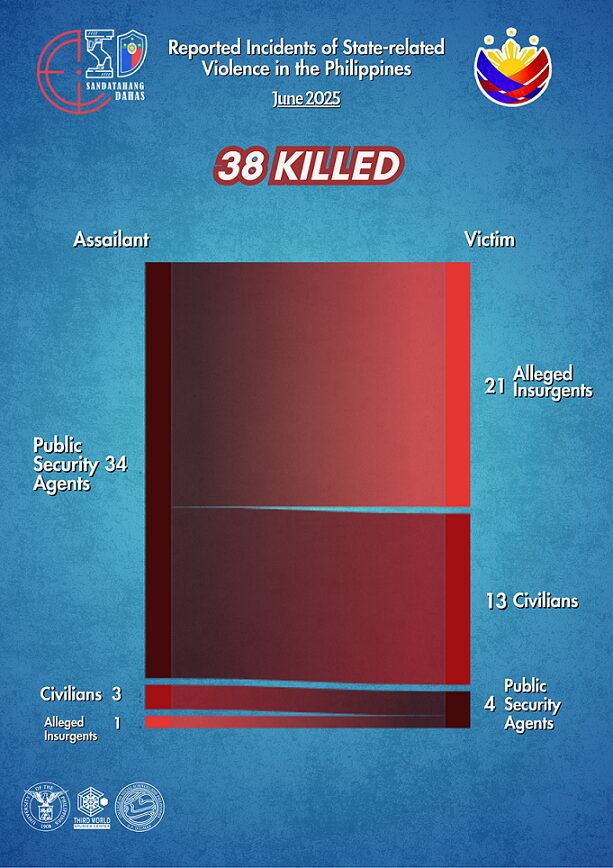
Police personnel were also responsible for 13 civilian deaths, mainly in the course of law enforcement operations. Most were targets of the operations; an exception is the case of Leo Vergel Fin Suico, a person with disability. A drunk Staff Sergeant Florante Peruchu Hoyle shot him dead. Suico was sleeping when the police officer barged into their house and shot him. The police reported that Hoyle could have mistaken Suico for someone else involved in a commotion moments before the killing.
In sum, of the 38 state-related killings, 35 were the result of the police’s and the military’s operations. Three of the deaths were attributed to other circumstances. This includes the case of Elioterio Ugking, a Lumad farmer; Leo Vergel Fin Suico, a PWD victim; and PSSg. Bobby Nanali, who was killed by his mother-in-law.
The June fatalities were mostly male (29 males and two females were killed; the sex of the seven other victims was unreported). The age of most of those killed was unreported, with 20 cases. Ten fatalities belong to the age range 20-29. Four fatalities are aged 30-39, while two fatalities were each recorded for those aged 40-49 and 50-59.
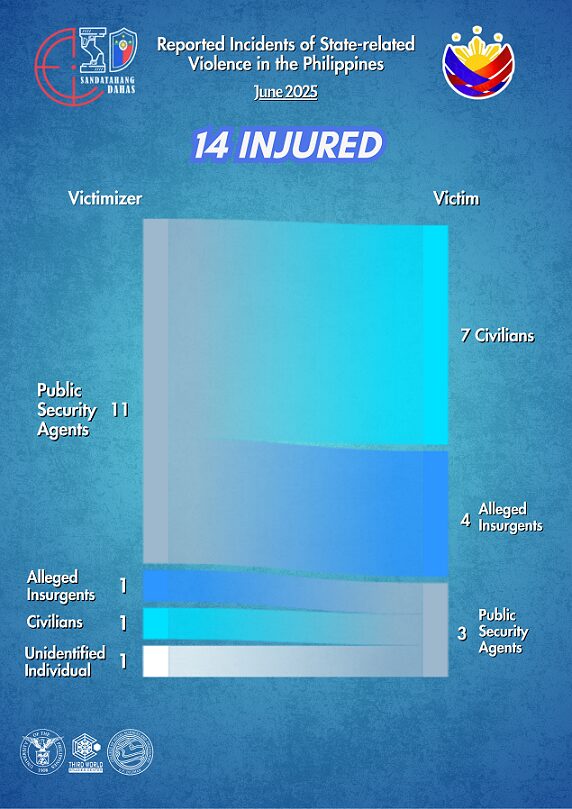
From 27 cases in May, the number of injured victims in state-related violence fell to 14 in June. May had the highest number of injuries inflicted on military and police personnel, totalling 15 cases. Conversely, half of the victims in June were civilians injured by the police and the military.
On June 22 in Pagadian City, Rechel Samo Nalzaro, wife of Jemboy Nalzaro, a Philippine Army enlisted personnel, refused to give her drunk husband PHP 2,000.00. He shot her in the foot. Since February, a total of eight similar incidents have been recorded where military and police personnel used their firearms in a domestic dispute.
If the police or the military personnel were not assaulting their partners when inebriated, they were taking it out on unsuspecting civilians. On June 21, in Batong Labang, Ilagan City, a stray bullet from a Glock 17 struck a 22-year-old female student in the right shoulder. The perpetrator was later identified as a corporal from the 5th Infantry Division Philippine Army in Gamu, Isabela.
In other cases, the civilians injured were the targets of police and military operations. On June 3, at midnight, the Bacolod City police received a report that a man in a computer shop was carrying a firearm. When the police approached the man identified as Jojo Arnaiz, he opened fire on the responding officers, who returned fire, wounding him before he was taken into custody.
Other than civilians, four alleged insurgents were also wounded in encounters with the military. The remaining three other cases involved assaults on members of the police and the military by an alleged insurgent, an unidentified individual, and a civilian.
Ten of these injuries occurred in the armed state actor’s conduct of official duty, one was classified as an attack against state forces, and three occurred in other circumstances, like those mentioned above involving a domestic dispute.
Similar to the count on killings, male individuals were the most injured this month, with ten victims. Meanwhile, two females were injured. The sex of two other victims was unreported. In five of the 14 cases, the age of the injured was unreported. Four injured victims belong to the age range of 30-39. Three injured victims are aged 20-29, while two injured victims were recorded for those aged 13-19.
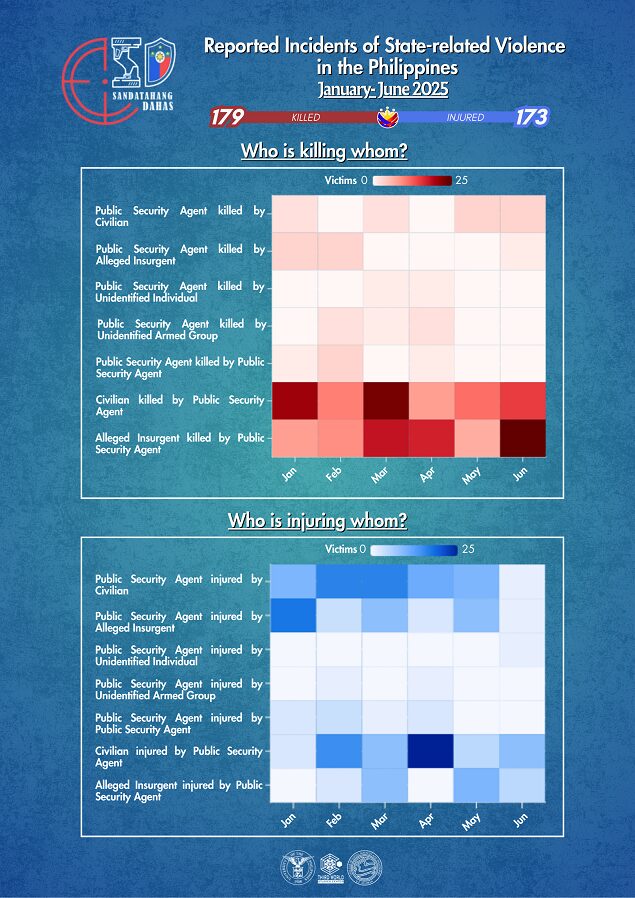
June, for now, has the lowest number of recorded injuries, indicating a downward trend, though monthly fluctuations persist. The monitor recorded a total of 36 injuries in February, marking the highest monthly figure of cases of injury. For comparison, January had 25 injuries; March, 34; April, 24; May, 27; and now June, 14.
Over the six-month period, Mindanao has consistently been a hotspot for state-related violence. In June alone, the region saw 15 killed and seven injured. Sultan Kudarat recorded the highest number of cases, with five killed and two injured. As for the other provinces in Mindanao, the monitor recorded one killed and another injured in Maguindanao del Norte, while in Maguindanao del Sur, two were killed and two injured. Meanwhile, Zamboanga del Sur reported a total of three victims, with two killed and one injured. In Surigao del Norte, three were killed, while Surigao del Sur reported one fatality. Agusan del Sur also recorded one killed, while Basilan reported one injured. With ten deaths specifically linked to insurgency-related operations, the concentration of anti-insurgency operations in this region shows the military’s continued focus on rooting out armed insurgent presence.
Visayas also saw a significant spike in cases this month, recording 17 incidents that left 13 killed and four injured. Northern Samar reported the highest number of fatalities, totaling six killed. Cebu reported three killed and two injured, Eastern Samar recorded one killed, while Negros Occidental reported one killed and one injured.
Meanwhile, Luzon reported ten fatalities and three injuries this month. NCR recorded the highest number of fatalities in the region, with two civilians and a police officer killed, followed by Quezon with two civilians killed. Cagayan, Basilan, Albay, Masbate, and Pangasinan each recorded a fatality. Meanwhile, Bataan, Nueva Ecija, and Isabela each reported an injury.
State-related violence in Luzon appears to be more dispersed, with incidents occurring across NCR, Central and Northern Luzon, and other provinces. A significant number of these cases were associated with operations conducted by the police.
Since the establishment of the Sandatahang Dahas monthly monitor, new cases have been emerging in various provinces that were not recorded before. In June 2025, incidents were reported for the first time in Cagayan, Eastern Samar, Nueva Ecija, Surigao del Norte, and Zamboanga del Norte. This geographic spread signals a broadening scope of conflict and operations.
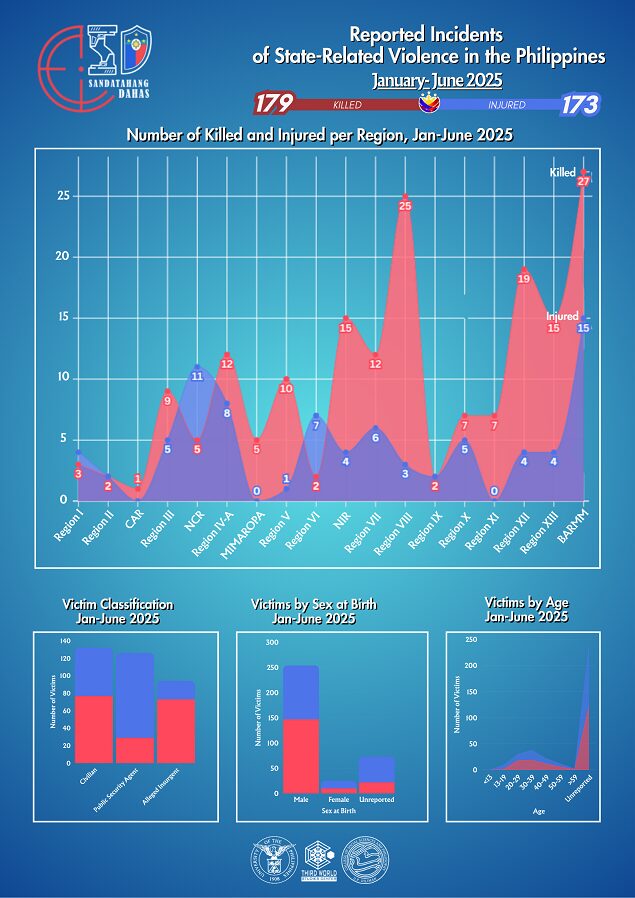
Halfway into 2025, state-related violence tallied a total of 179 killings and 173 injuries throughout the country. Amidst these incidents, President Ferdinand “Bongbong” Marcos Jr. stated in his speech during the commemoration of the 83rd Araw ng Kagitingan that “the solution to war is not more war, and that the solution to war is only peace—an honorable peace that is arrived at by the different parties involved and having a hand and a voice in achieving that peace.” The monthly monitor shows the contradictions between President Marcos’s claim and the actions of the state.
With insurgency-related fatalities reaching a new peak in June, the coming months will be crucial in understanding whether these figures represent an isolated spike or an emerging pattern in the conduct of state forces.
[The authors are interns at the Third World Studies Center, College of Social Sciences and Philosophy, University of the Philippines Diliman. They are political science students from the Department of Social Sciences, College of Arts and Sciences, University of the Philippines Manila. Graphics by Aidrielle Raymundo. To learn more about Sandatahang Dahas, visit its website and for the latest updates, follow the Dahas Project in these social media platforms: X (formerly Twitter), Instagram, Threads, and Bluesky. Reports for the previous months are available at https://dahas.upd.edu.ph/sd-monthly-reports/.]
